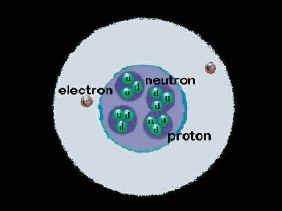BACKGROUND:
The field of physics is generally
broken into discrete categories of mechanics, heat, energy, sound,
light, magnetism, electricity, optics and those of atomic or nuclear
structure. These traditional topics reflect the historical development
of physics throughout the years in search for a unified field theory. A
unified theory which can explain how all these forces and energy, in the
Universe, work together. The search of a grand unified theory of all
matter, sometimes border on ingenuity than it does on concrete facts.
Recent theoretical investigations point to symmetry as an underlying law
of physics. This "supersymmetry" could have been broken as the
Universe evolved. Physicists are now trying to put the symmetry back
together. This almost sounds fun!
Physics is a fundamental science
which explains most phenomena that occurs in our world. Physics can be
explained as the study of matter and energy. Physics is made up of many
different components.
PROCEDURE:
-
Ask students what
"phenomena" can be considered physics. Make a list of their
answers on the board and try to draw out the following topics: motion,
force, energy, matter, sound, electricity, magnetism, light and atoms.
-
Introduce
electricity and magnetism. Explain that electricity and magnetism are
not completely understood. There are many proposed theories but no one
knows the complete answer. Discuss the structure of the atom. Make sure
students understand that the nucleus
 contains protons and neutrons. The
outer shells of the atom have electrons that spin in different orbits.
It is the movement of these electrons when they "escape" from
the atom that cause electricity; and the spinning direction, when still
part of the atom, that causes magnetism. Electricity and magnetism are
fundamentally related through electrons. Students will learn that
electricity can make magnetism and magnetism can make electricity. It is
important to repeat this to your students. Review some of the third
grade labs if students seem confused. contains protons and neutrons. The
outer shells of the atom have electrons that spin in different orbits.
It is the movement of these electrons when they "escape" from
the atom that cause electricity; and the spinning direction, when still
part of the atom, that causes magnetism. Electricity and magnetism are
fundamentally related through electrons. Students will learn that
electricity can make magnetism and magnetism can make electricity. It is
important to repeat this to your students. Review some of the third
grade labs if students seem confused.
-
Electricity is
energy produced through the movement of
electrons. Electricity has no color, weight, or odor. Electricity
produces energy in the form of a "charge." If the charge is
not controlled, it is called "static electricity." If the
charge is controlled it is called an "electrical current."
-
Magnetism is a
force that is produced because of the spin of electrons in the same
direction. Magnetism has no color, weight, or odor. Ask students to give
examples of observable electrical and magnetic forces and write them on
the board. Students should remember basic principles from the third
grade. Refresh their memory.
|
ELECTRICITY |
MAGNETISM |
|
circuit |
magnet |
|
lamp |
lodestone (magnetite) |
|
sparks |
generators |
|
static |
compass |
|
turn on appliances |
magnetic resonance image
(MRI
- machine that looks at the image of your body without surgery) |
|